Choosing the right framework can make a significant difference in the efficiency and effectiveness of your testing efforts. Two popular choices for test case automation in a behavior-driven development (BDD) environment are the Karate framework and the Cucumber framework. APIs are the often-overlooked web application components that empower several apps to make our lives easier. For instance, Internet banking, online shopping, and online streaming service apps use APIs to integrate, communicate, and generate results and content for their users. For web developers, testing the functionality of these APIs is crucial for ensuring proper performance. Tools such as SoapUI, Postman, and JMeter are commonly used for API testing. We shall explore the features, advantages, and disadvantages of Karate and Cucumber frameworks in this blog to help you make an informed decision for API test automation needs.
Karate Framework
Karate Framework is an open-source, BDD testing framework designed for API test automation, performance testing, and UI (user interface) testing. Leveraging the foundation of Cucumber and employing the Gherkin Syntax, Karate provides a user-friendly testing environment. Notably, even testers without a programming background can efficiently conduct tests using the Karate framework as in the Cucumber framework. Karate is a general-purpose test automation framework that can script calls to HTTP endpoints and assert that the JSON or XML responses are as expected.
Although Karate is coded using Java, the test scripts are composed in Gherkin. This approach stems from Karate’s initial roots as an extension of the Cucumber framework. Karate is a relatively new automation testing framework that has gained popularity in recent years. It is designed specifically for testing web services and APIs and is built on top of the popular automation library, Apache HTTP Client. Karate framework is the only API testing tool that has combined API automation and performance testing into a single standalone tool.
Here are some key features of the Karate framework:
- Built-in BDD Support: Karate is designed with BDD in mind, making it easy for testers and developers to write tests in a human-readable, low-code programming format using Gherkin syntax.
- RESTful API Testing: Karate excels in testing RESTful APIs, making it an ideal choice for teams focusing on API testing.
- Single Test Script: Karate promotes single test script creation that contains both test scenarios and HTTP requests, simplifying test maintenance and readability.
- Data-Driven Testing: Karate offers built-in support for data-driven testing, making it easier to test multiple scenarios with different data inputs.
- JavaScript for Complex Scenarios: For more complex scenarios, Karate allows you to use JavaScript directly within your test scripts, providing flexibility and extensibility.
Cucumber Framework
Cucumber is one of the oldest and most widely used BDD testing frameworks in the industry. It supports multiple programming languages including Java, Ruby, and Python, and is often used for end-to-end testing scenarios.
Here are some key features of the Cucumber framework:
- Language Flexibility: Cucumber supports multiple programming languages, making it suitable for teams with varied language preferences.
- Wide Adoption: Cucumber has been in the market for a long time, which means it has a vast user base and extensive documentation.
- Support for Web and Mobile: Cucumber is versatile and can be used for testing both web and mobile applications, making it a preferred choice for many testing teams.
- Integration Capabilities: Cucumber easily integrates with various testing tools and continuous integration systems, making it suitable for complex testing environments.
- Parallel Execution: Cucumber supports parallel test execution, allowing faster test runs and improved efficiency.
Differences between Karate and Cucumber Frameworks
While both Karate and Cucumber frameworks are open-source and support BDD frameworks, there are key differences that set them apart:
| KARATE | CUCUMBER |
| Karate focuses primarily on API automation testing, performance testing, and UI testing. | Cucumber focuses on acceptance testing. It is more versatile, supporting web and mobile testing. |
| Built-in step definitions- Karate wins in terms of ease of use due to its built-in BDD support and the ability to write tests in a single script. | Need to write step definitions. |
| Native support for CSV files. | Third-party app for CSV files. |
| Capable of parsing JSON files within a feature file. | Must create a JSON reader class. |
| Feature files are reusable. | Feature files are not reusable. |
Pros and Cons of Karate Framework
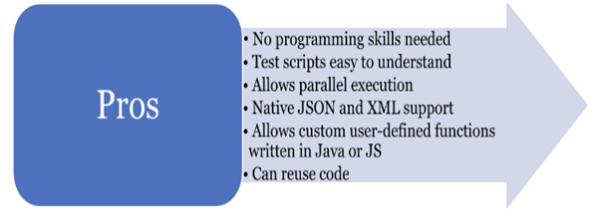
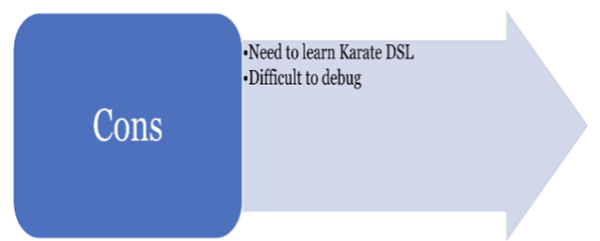
Prerequisites for Learning Karate Framework
No previous programming expertise is necessary for the Karate framework. Essential prerequisites include critical thinking abilities, a basic understanding of APIs, and a willingness to learn new skills.
Before diving into Karate, ensure you have the following tools handy:
- Java 8 or later.
- JDK, OpenJDK, or JRE.
- IDE, Eclipse, Visual Studio Code, or IntelliJ. Using a standalone JAR file that Karate can use without an IDE.
- Maven or Gradle.
Uses of Karate Framework
API Testing
APIs serve as the middle layer of web applications, providing business logic and communication capabilities. Karate can assess runtime errors, identify security vulnerabilities, uncover invalid data, detect authentication errors, and evaluate performance issues even under substantial traffic or load conditions. Below is a feature file example for posting and getting information from a test booking site.
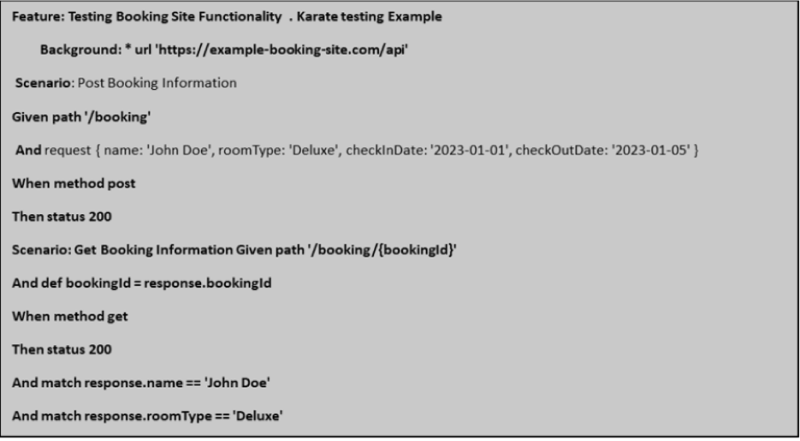
UI Testing
Karate Framework also supports UI testing to ensure a positive user experience. It can evaluate the performance of links, navigation, search functions, and other functionalities. Provided below is an illustration of a feature file, showcasing the process of locating a graduate certificate program.
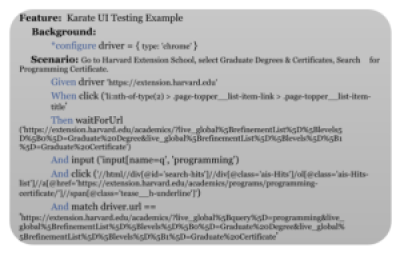
Performance Testing
Slow websites and applications lead to low customer satisfaction. Karate framework performs performance testing via integration with Gatling, an open-source framework for load and performance testing. Test scripts use either Java or Scala, in addition to the Gherkin-style syntax.
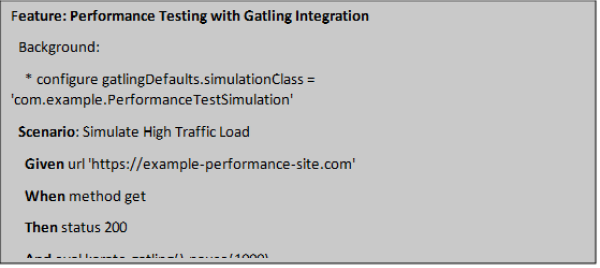
Conclusion
Choosing between the Karate framework and the Cucumber framework depends on your specific testing needs and team expertise. If you primarily focus on API testing and prefer a straightforward BDD approach, Karate could be an excellent choice. On the other hand, if you require versatility across web and mobile testing, have a team with varied language skills, and need extensive documentation, Cucumber may be the better option.
The Karate framework is a cost-free, open-source tool tailored for automation testing. Distinguished from its counterparts, Karate stands out with its multifaceted capabilities. Its proficiency in conducting API, UI, and performance tests, along with the capacity to create mock servers, positions Karate as a frontrunner in the industry. For organizations seeking to automate test scripts, reduce costs, and leverage existing expertise, exploring Karate is highly recommended. Ultimately, the decision should be based on the project requirements, team skillset, and long-term testing goals. Both frameworks are capable of delivering effective BDD automation testing, so you cannot go wrong with either choice.
We offer a wide range of software testing services to help you deliver high-quality software to your customers. If you have any queries regarding our services, feel free to contact us at itsolutions@milestone.tech.




